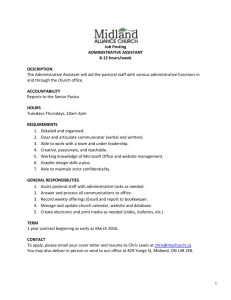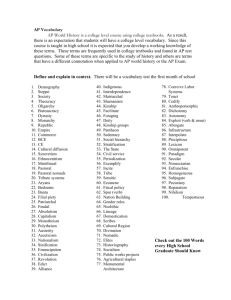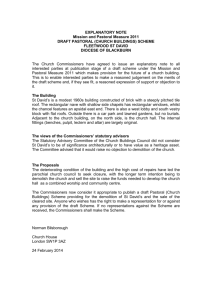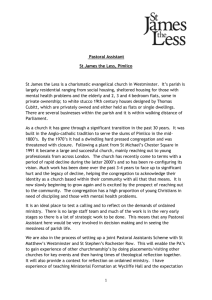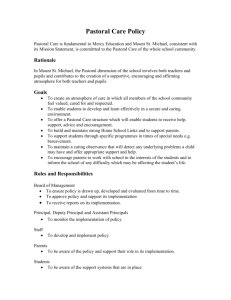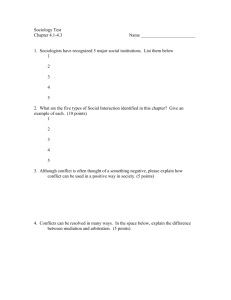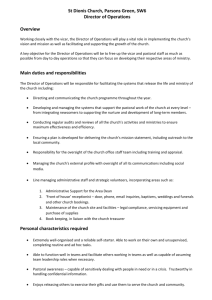The Pastoral Pipes
advertisement
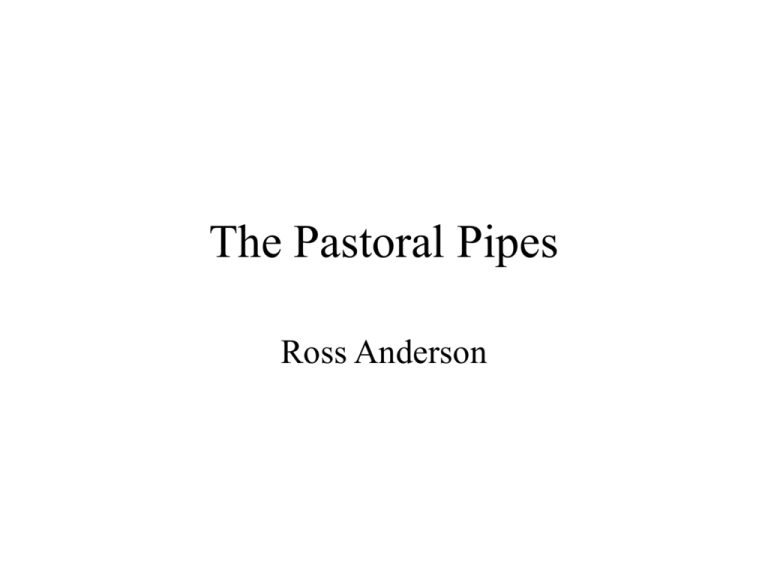
The Pastoral Pipes Ross Anderson Outline of Talk • • • • • • • The written sources The instruments Getting a period instrument playing again Geoghegan Tuning What this teaches about 18th century music What we still don’t know Earliest Days • Many European countries have pipes that play an octave plus a few notes (gaita, cornemuse, …) • Pipes were based on shawms, and the typical shawm plays a few second-octave notes depending on the reed and the player • By the second quarter of the 18th century, we find evidence of a more developed chanter • Maybe someone put an oboe into a set of border pipes, or based a chanter on an oboe Border Pipes • ‘Old Geordy’ Sime, Dalkeith town piper and retainer to the Duke of Buccleugh • Painting by John Kay, about 1789 • Contemporary of travelling piper Jamie Allan Oboe, Grand Bourbonnais, Pastoral Chanters, Union Chanter Beggar’s Opera, 1728 The Written Sources • ‘The Compleat Tutor for the Pastoral or New Bagpipe’, John Geoghegan, 1743 • First book of bagpipe music published • Describes an instrument with an open end and range from low C to third-octave D, A drones • Text describes both Scots and Irish piping gracings • Repertoire: a mixture of traditional Scots/Irish tunes, popular airs, and pieces for the oboe Objections to Geoghegan • There’s certainly some interesting material (e.g. “A Bagpipe Concerto call’d the Battle of Aughrim, or the Football March”) • But also tunes in keys like F and B flat – surely these don’t work well with A drones? • One tune has a low C sharp! • Consensus up till now: Geoghegan overstated his expertise Advocates’ Manuscript • Found in National Library of Scotland • Classed as union pipe music, but several tunes have low C • I got permission to scan it and put it online (see www.piob.info) • Mostly Scottish dance tunes; some Irish • Wrote ‘The pastoral pipe repertoire, rediscovered’, Common Stock v 20 no 2 (Dec 2005) The Sutherland Manuscript • In the Mitchell Library in Glasgow • Hundreds of tunes – mostly Scots, many Irish, also variation sets and popular airs • Only three ‘pastoral’ tunes with low C – the rest are playable on modern uilleann pipes • There’s also a fingering chart for the highland pipes showing two second-octave notes! • See ‘The Sutherland Manuscript’, An Piobaire, 2006 Later Sources • O’Farrell's Collection of National Irish Music for the Union Pipes, 1804 • O’Farrell taught music in London and played on stage – ‘Oscar and Malvina’ was a hit in 1791 Later Sources (2) • O’Farrell's Pocket Companion for the Irish or Union Pipes, 4 volumes 1805-10 • The MacKie Manuscript, 1828 • The Millar Manuscript, 1830 • Colclough’s Tutor, 1840 Late Pastoral Pipes • The MacKie set of pastoral pipes, 1828 • National Museum of Scotland • Came with manuscript of music, now online at www.piob.info Iconographic & other sources … • ‘The Dance of the Little People’, William Holmes Sullivan (early 19th century) • Other references to ‘the long chanter’ up till about WW1 • Sam Grier The Instruments • Pastoral and early union pipes are found in many collections – notably the National Museum of Scotland and the Chantry at Morpeth • See Hugh Cheape, ‘Bagpipes’, NMS, 2008 • Replicas have been made by Brian McCandless, Sean Folsom, Michael McHarg, Chris Bayley, Jon Swayne • I have two sets that were sold and Sotheby’s in 1994, then owned by John Hughes and Ken McLeod Getting an old instrument playing • Ken McLeod fitted a new bag • Bass drone reed borrowed from another old set • The big problem with old pastoral chanters was always thought to be the chanter reed – the C, E always out of tune • Breakthrough at WKPF 2007 – I got a few narrowbore D reeds from Joe Kennedy and also played two chanters owned by Hamish Moore • All four chanters played the same! The Late 18C Pastoral Scale • Open – with the foot joint – the chanter plays like a highland chanter (but LH notes slightly flat unless some RH fingers raised) • Closed it plays like a union pipe except that C nat is x oxo xxxx and C# is o xxo xxxx • So you can play either Irish or Scots style! • The cost is that the open second octave has some out-of-tune notes (notably E!) The Key Insight • The reason people have struggled to reed pastoral chanters is not that making the reed is an impossible lost art… • It’s just that the scale is fingered differently! • I visited Jon Swayne and we played all combinations of our reeds and chanters • It turned out that when he’d copied my chanter, he’d moved the first finger hole up 3mm to make the open C#, as on a modern chanter • Looking at old fingering charts, this is obvious! Voicing for an Open Scale • Jon Swayne’s copy of my set, with the first finger hole 3mm up the chanter, is also voiced to give a more in-tune E with the foot joint on • It plays well open across two octaves • Performance closed is OK but lacks bite, the low C tends to autocran, and it’s easy to get into the wrong octave (the reed is much softer than mine) • But it seems an appropriate instrument to play the Sutherland repertoire Chanter Evolution? • • • • • • 1700: border pipe: octave plus a few notes 1740: baroque oboe, in-tune played open 1760: people start playing staccato 1780: chanters being optimised for this 1800: recognisably modern chanters 1820: foot joints stop being made Unexpected Research Holdup… Later Chanter Evolution • The earliest chanter with modern fingering is the James Kenna set donated by Ken McLeod and played by Ronan Browne • Even so, this has some slightly odd crossfingerings (as do sets until the 1840s) • See for example fingering charts from O’Farrell, 1804 – he has a cross-fingered second octave C nat, and some notes must be played open • Fully modern fingering – 1815? Implications for Music • First, we can rehabilitate John Geoghegan! • Pastoral chanters have small finger holes and so cross-finger well, like a recorder • No problem playing in F, G minor … • Geoghegan’s set had A drones (as did a set in Newcastle in early 20C) which probably could tune to B flat • The low C sharp was the bell note with foot joint off for the oboe – and for Sean Folsom’s repro set Implications for Music (2) • Older tunes tend to use C nat – e.g. listen to Kitty’s Rambles by Leo Rowsome • Even although C# is playable, it’s simpler to play the natural scale in fast dance music • Big source of ‘pastoral’ tunes is the Goodman manuscript – tunes from West Ireland in 1860s • Johnny Doran’s music also has pastoral flavour • Older instruments likely to remain in use longer in more remote and marginalised communities Next steps • Let’s get more 18th century sets going • Even if museum sets can’t be refurbished their chanters can still be played • Then look again at manuscript sources once we understand chanter evolution timelines • Precedent: the early music movement – ‘historically inspired performance’ Conclusion • The pastoral pipe is the missing link in the evolution from the 17th century border pipe / gaita / cornemuse design to the 19th century union pipe • It wasn’t one single design, but a progression • The music also evolved through the 18th century • Instruments stayed able to play ‘highland’ too • Their footprints in modern Scots and Irish music are evident once we know what to look for • And it’s time to rehabilitate John Geoghegan!
